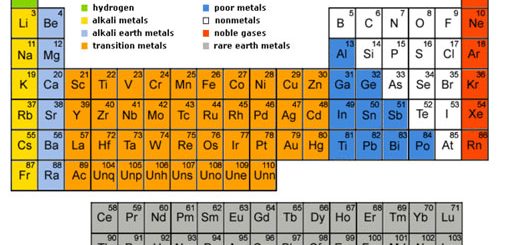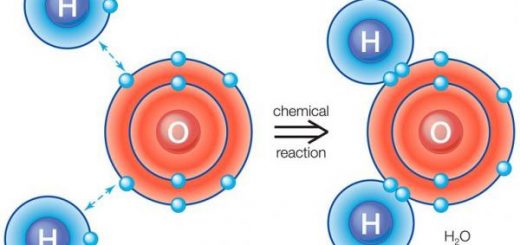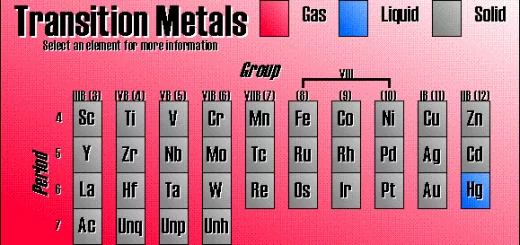Radius property, Ionization potential, Electron affinity and Electronegativity
The chemical properties & some of the physical properties of the elements depend on their electronic structure and especially on the valence electrons (the electrons of the outermost level), The concept of bond length differs in the covalent compounds from that in the ionic compounds, we can calculate atomic radius and ionic radius.
Radius property
The atomic radius can not be calculated from the distance between the nucleus and the farthest electron, Because it is impossible to determine the precise location of an electron around the nucleus ( as wave mechanics revealed).
But the atomic radius can be calculated by knowing the covalent bond length which is measured by Angestrom unit (A°), Covalent bond length (2r) is the distance between the nuclei of two bonded atoms, Atomic radius (r) is half the distance between the centers of two similar atoms in a diatomic molecule.
Covalent bond length = sum of the two atomic radii of the molecule
The atomic radius (r) = ½ × bond length in a diatomic element molecule (2r)
Ionic radius: The ionic compounds as sodium chloride are found in a crystalline form and consist of positive ions (cations) and negative ions (anions), Ionic bond length is the distance between the centers of the nuclei of two bonded ions, The ionic radius depends on the number of electrons lost or gained to form ions.
The ionic bond length = the sum of two ionic radii of the formula unit
The effective nuclear charge concept (Zeff)
The valence electrons are not affected by the complete nuclear charge (the charge of the nucleus protons), This is because the inner electrons (of the inner energy levels) screen a part of this charge from the valence electrons, so, the actual charge affecting an electron is called the effective nuclear charge Zeff.
Effective nuclear charge Zeff is the actual nuclear charge (positive charge) that effects on an electron in an atom, The effective nuclear charge Zeff is always less than the nuclear charge (the total number of protons present in a nucleus), due to the screening effect of the electrons of the inner energy levels on a part of the nuclear charge affecting the electrons under study.
Graduation of atomic radius property in the periodic table
In the horizontal period: The atomic radius decreases as we go from the left to the right across a period by increasing the atomic number from 1A to zero group.
This is due to the gradual increase in the effective nuclear charge (Zeff) which increases the nuclear attraction force on the valence electrons leading to the reduction of the atomic radius.
In the vertical group: The atomic radius increases as we go down the group by increasing the atomic number from the first period to the seventh.
This is due to the increase in the number of energy levels in each new period, The increase in the number of the filled energy levels that have a screening effect on the pull of the nuclear charge on the outer electrons, The increase of the repulsive forces between electrons.
The atoms of the first group of elements (alkalis) are the biggest atoms, while the atoms of the seventh group elements (halogens) are the smallest atoms, The biggest atom in size is cesium (Cs).
Example: 7N, 9F → (N) atom is bigger than (F) atom because the atomic size decreases in the same period as we go from left to right by increasing the atomic number.
56Ba, 4Be → (Ba) atom is bigger than (Be) atom because the atomic size increases in the same group as we go down the group by increasing the atomic number.
Relation between the radii of atoms and their ions
The radii of atoms differ from the radii of their ions, The ionic radius decreases as the effective nuclear (positive) charge of the ion increases.
Metals: The metal atoms tend to lose their valence electrons during the chemical reaction to form positive ions.
The positive ion radius is smaller than its atomic radius, because the number of positive protons in the cation ( positive ion) is larger than the number of negative electrons, So, the pull of the effective nuclear charge on remaining electrons increases leading to decrease the size.
Application: The sodium metal tends to lose its valence electron during chemical reactions to form a sodium ion of radius smaller than the radius of its atom.
Nonmetals: The nonmetals atoms tend to gain electrons during the chemical reaction to form negative ions.
The negative ion radius is larger than its atomic radius, because the number of negative electrons in the anion (negative ion) is larger than the number of positive protons, so, the repulsive forces between electrons increase due to increasing the number of electrons without any increasing in the nuclear charge leading to increase the size.
Application: The chlorine nonmetal tends to gain an electron during chemical reactions to form chloride ion of a radius larger than the radius of its atom.
Application: The atomic radius of the iron atom (Fe) > the ionic radius of iron (II) ion Fe2+ > the ionic radius of iron (III) ion Fe3+, because the atomic radii of metals are bigger than the radii of their ions, As the ionic radius of positive ion decreases, its charge increases.
Ionization potential (Ionization energy)
If an energy is supplied to an atom, electrons may be excited and transferred to higher energy levels, but if a sufficient energy is supplied, the most loosely bound electron may be completely removed, giving a positive ion, The minimum amount of this energy is called ionization potential.
Ionization potential (Ionization energy) is the amount of energy required to remove the most loosely bound electron completely from an isolated gaseous atom.
ΔH of the ionization process has a positive sign, because the ionization energy is an absorbed energy.
Na(g) + Energy → Na+(g) + e– , ΔH = + 496 kJ/mol
The atom of the same element has more than ionization energy:
First ionization potential is the amount of energy required to convert an isolated gaseous atom to an ion carries one positive charge.
M(g) + Energy → M+(g) + e– , ΔH = (+)
The second ionization potential is the amount of energy required to remove an electron from a positive ion carries one positive charge.
M+(g) + Energy → M2+(g) + e– , ΔH = (+)
Third ionization potential is the amount of energy required to remove an electron from a positive ion carries two positive charges.
M2+(g) + Energy → M3+(g) + e– , ΔH = (+)
The first ionization potential < the second ionization potential < the third ionization potential.
Application: The first ionization potential of noble gases and alkali metals
The first ionization potential of noble gases is very high, due to the stability of their electronic configuration and it is difficult to remove an electron from a filled shell.
Example : 19Ne : [ 2He ] , 2s² , 2p6 , 18Ar : [ 10Ne ] , 3s² , 3p6
The first ionization energy of energy alkali metals is lower than that of all elements, due to the easily loss of the valence electron.
Example : 11Na : [ 10Ne ] , 3s¹ , 19K : [ 18Ar ] , 4s¹
The ionization potentials of magnesium: The second ionization energy of magnesium is greater than the first one, due to the increasing of the effective nuclear charge (Zeff), The third ionization potential of magnesium is much greater than that of its first and second ones, because it results in the breaking up of a completely filled energy level.
Mg(g) → Mg+(g) + e– , ΔH1 = ( + 737 kJ/mol )
Mg+(g) → Mg2+(g) + e– , ΔH2 = ( + 1450 kJ/mol )
Mg2+(g) → Mg3+(g) + e– , ΔH3 = ( + 7730 kJ/mol )
The first ionization potential of potassium 19K is lower than that of calcium 20Ca, while the second ionization potential of potassium is much greater than that of calcium.
19K : [ 18Ar ] , 4s¹ , 20Ca : [ 18Ar ] , 4s²
The first ionization potential of potassium is lower than that of calcium due to the easily loss of valence electron, while the second ionization potential of potassium is much greater than that of calcium because it results in the breaking up of a completely filled shell.
The graduation of ionization potential in the periodic table:
In the same period: The first ionization potential increases as we move from left to right, This is due to the increase of the effective nuclear charge and the decrease of the atomic radius, which would lead to increase the attraction force of the nucleus on the valence electrons, which need higher energy to separate them from the atom.
In the same group: The first ionization energy decreases as we go down the group, This due to the extra shells of electrons are added which increase the atomic radius, The decrease of attraction force of the nucleus on the valence electrons, so, the energy required to remove the valence electrons decreases, So, the ionization potential is inversely proportional to atomic radius.
The ionization potential of oxygen 8O is lower than that of nitrogen 7N, although oxygen comes next nitrogen through the same period , because the atom becomes more stable when the 2p sub-level is half-filled electrons as in nitrogen atom and removing an electron from it will decrease its stability.
Example: Mention which atom is higher in ionization potential in each of the following pairs of atoms:
13Al, 16S: The ionization potential of 16S is greater than that of 13Al because the ionization potential increases in the same period as we move left to right by increasing the atomic number.
3Li, 55Cs: The ionization potential of 3Li is greater than that of 55Cs because the ionization potential decreases in the same group as we move down the group by increasing the atomic number.
Electron affinity
The removal of an electron from the atom will convert it into a cation, which requires an amount of energy named by the first ionization energy, on the other hand, if the atom gained an extra electron, it will be converted into a negative ion, this is associated with releasing an amount of energy named by electron affinity.
Electron affinity is the amount of energy released when an extra electron is added to a neutral gaseous atom, The magnitude of the electron affinity is high when the added electron makes the sub-level, half-filled or completely filled, as in both cases it helps in the stability of the atom.
X(g) + e– → X−(g) + Energy , ΔH = ( − )
The graduation of electron affinity in the periodic table
In the same period: The electron affinity increases as we move from left to right, this is due to the increase of the atomic number leading to decrease the atomic radius (atomic size), which makes it easier for the nucleus to attract a new electron.
In the same group: The electron affinity decreases as we go down the group, This is due to the increase of the atomic number leading to increase the atomic radius (atomic size), so, the ability of the nucleus to attract the new electron decreases.
The electron affinity values for beryllium, nitrogen and neon are close to zero , 4Be: 1s², 2s2 , 7N: 1s², 2s2, 2p3, 10Ne: 1s², 2s2, 2p6
Because the atom will be more stable when the sublevel: 2s is full-filled as in the case of beryllium atom 4Be, 2p is half-filled as in the case of nitrogen atom 7N, 2p is full-filled as in the case of neon atom 10Ne and the addition of an electron to any atom of them will decrease its stability.
The electron affinity of chlorine ( − 348.6 kJ/mol ) is greater than the electron affinity of flourine ( − 328 kJ/mol ) , although chlorine comes next fluorine through the same group.
Because fluorine atom is smaller in size as it has smaller radius than chlorine atom, so, the entering of an electron will suffer a strong repulsive force with the nine electrons already existing around the fluorine nucleus which decreases the released energy due to consuming a part of it to overcome this repulsive force.
Electronegativity
When two atoms of two different elements combine together, the ability of one atom of them to attract the electrons of the chemical bond towards itself differs from that of the other atom, this attraction force is named by electronegativity, Electronegativity is the tendency of an atom to attract the electrons of the chemical bond to itself.
The electron affinity differs from the electronegativity, where the electron affinity is an energy term which refers to an atom in its single state, while the electronegativity of the elements is represented by relative values and it refers to a combined atom.
The increase of the relative values of the electronegativity means the increase in the ability of the element atom to attract the electrons of the chemical bond.
The difference in electronegativity between elements plays a very important role in determining the nature of the bond formed between them.
The graduation of electronegativity in the periodic table:
In the same period: The electronegativity increases as we move from left to right, this is due to the increase of the atomic number leading to decrease atomic radius, so, the ability of the atom to attract the electrons of the bond towards itself increases.
In the same group, The electronegativity decreases as we go down the group, this is due to the increase of the atomic number leading to increase the atomic radius, so, the ability of the atom to attract electrons of the bond towards itself decreases.
So, The atoms of nonmetals group 7A ( halogens ) are the greatest in the electronegativity, while the atoms of the alkali metals group 1A are lowest in the electronegativity.
Fluorine ( F ) is considered to be the most electronegative element, while cesium (Cs) is considered to be the lowest electronegative element.
Modern periodic table and classification of Elements
Metallic & nonmetallic property, Acidic & basic property in the periodic table
Graduation of the properties of the elements in the modern periodic table



